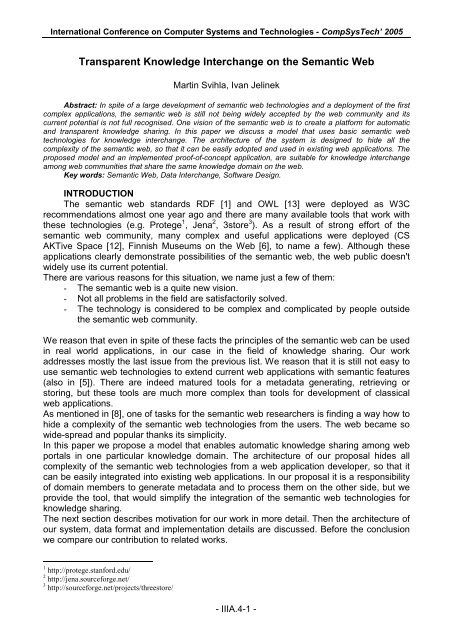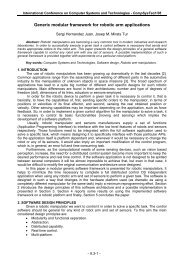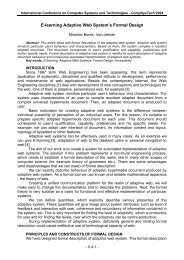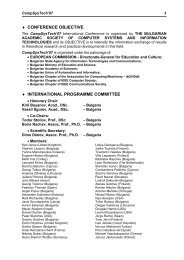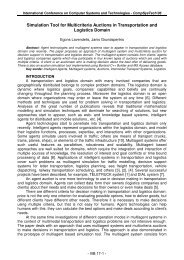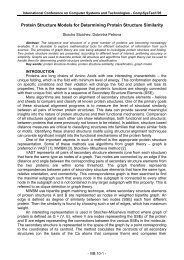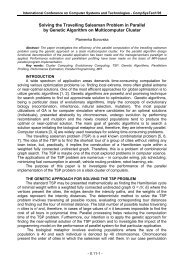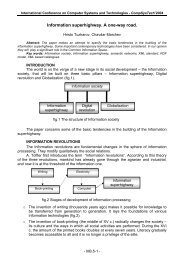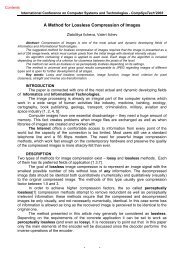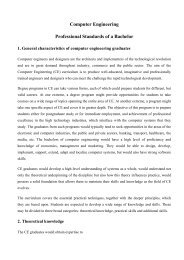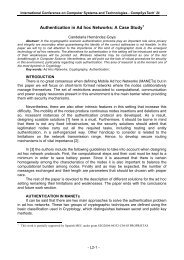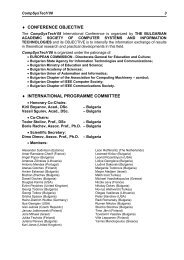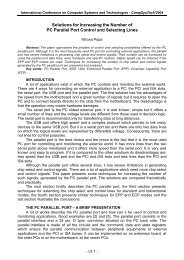Transparent Knowledge Interchange on the Semantic Web - Ecet
Transparent Knowledge Interchange on the Semantic Web - Ecet
Transparent Knowledge Interchange on the Semantic Web - Ecet
You also want an ePaper? Increase the reach of your titles
YUMPU automatically turns print PDFs into web optimized ePapers that Google loves.
Internati<strong>on</strong>al C<strong>on</strong>ference <strong>on</strong> Computer Systems and Technologies - CompSysTech’ 2005<br />
<str<strong>on</strong>g>Transparent</str<strong>on</strong>g> <str<strong>on</strong>g>Knowledge</str<strong>on</strong>g> <str<strong>on</strong>g>Interchange</str<strong>on</strong>g> <strong>on</strong> <strong>the</strong> <strong>Semantic</strong> <strong>Web</strong><br />
Martin Svihla, Ivan Jelinek<br />
Abstract: In spite of a large development of semantic web technologies and a deployment of <strong>the</strong> first<br />
complex applicati<strong>on</strong>s, <strong>the</strong> semantic web is still not being widely accepted by <strong>the</strong> web community and its<br />
current potential is not full recognised. One visi<strong>on</strong> of <strong>the</strong> semantic web is to create a platform for automatic<br />
and transparent knowledge sharing. In this paper we discuss a model that uses basic semantic web<br />
technologies for knowledge interchange. The architecture of <strong>the</strong> system is designed to hide all <strong>the</strong><br />
complexity of <strong>the</strong> semantic web, so that it can be easily adopted and used in existing web applicati<strong>on</strong>s. The<br />
proposed model and an implemented proof-of-c<strong>on</strong>cept applicati<strong>on</strong>, are suitable for knowledge interchange<br />
am<strong>on</strong>g web communities that share <strong>the</strong> same knowledge domain <strong>on</strong> <strong>the</strong> web.<br />
Key words: <strong>Semantic</strong> <strong>Web</strong>, Data <str<strong>on</strong>g>Interchange</str<strong>on</strong>g>, Software Design.<br />
INTRODUCTION<br />
The semantic web standards RDF [1] and OWL [13] were deployed as W3C<br />
recommendati<strong>on</strong>s almost <strong>on</strong>e year ago and <strong>the</strong>re are many available tools that work with<br />
<strong>the</strong>se technologies (e.g. Protege 1 , Jena 2 , 3store 3 ). As a result of str<strong>on</strong>g effort of <strong>the</strong><br />
semantic web community, many complex and useful applicati<strong>on</strong>s were deployed (CS<br />
AKTive Space [12], Finnish Museums <strong>on</strong> <strong>the</strong> <strong>Web</strong> [6], to name a few). Although <strong>the</strong>se<br />
applicati<strong>on</strong>s clearly dem<strong>on</strong>strate possibilities of <strong>the</strong> semantic web, <strong>the</strong> web public doesn't<br />
widely use its current potential.<br />
There are various reas<strong>on</strong>s for this situati<strong>on</strong>, we name just a few of <strong>the</strong>m:<br />
- The semantic web is a quite new visi<strong>on</strong>.<br />
- Not all problems in <strong>the</strong> field are satisfactorily solved.<br />
- The technology is c<strong>on</strong>sidered to be complex and complicated by people outside<br />
<strong>the</strong> semantic web community.<br />
We reas<strong>on</strong> that even in spite of <strong>the</strong>se facts <strong>the</strong> principles of <strong>the</strong> semantic web can be used<br />
in real world applicati<strong>on</strong>s, in our case in <strong>the</strong> field of knowledge sharing. Our work<br />
addresses mostly <strong>the</strong> last issue from <strong>the</strong> previous list. We reas<strong>on</strong> that it is still not easy to<br />
use semantic web technologies to extend current web applicati<strong>on</strong>s with semantic features<br />
(also in [5]). There are indeed matured tools for a metadata generating, retrieving or<br />
storing, but <strong>the</strong>se tools are much more complex than tools for development of classical<br />
web applicati<strong>on</strong>s.<br />
As menti<strong>on</strong>ed in [8], <strong>on</strong>e of tasks for <strong>the</strong> semantic web researchers is finding a way how to<br />
hide a complexity of <strong>the</strong> semantic web technologies from <strong>the</strong> users. The web became so<br />
wide-spread and popular thanks its simplicity.<br />
In this paper we propose a model that enables automatic knowledge sharing am<strong>on</strong>g web<br />
portals in <strong>on</strong>e particular knowledge domain. The architecture of our proposal hides all<br />
complexity of <strong>the</strong> semantic web technologies from a web applicati<strong>on</strong> developer, so that it<br />
can be easily integrated into existing web applicati<strong>on</strong>s. In our proposal it is a resp<strong>on</strong>sibility<br />
of domain members to generate metadata and to process <strong>the</strong>m <strong>on</strong> <strong>the</strong> o<strong>the</strong>r side, but we<br />
provide <strong>the</strong> tool, that would simplify <strong>the</strong> integrati<strong>on</strong> of <strong>the</strong> semantic web technologies for<br />
knowledge sharing.<br />
The next secti<strong>on</strong> describes motivati<strong>on</strong> for our work in more detail. Then <strong>the</strong> architecture of<br />
our system, data format and implementati<strong>on</strong> details are discussed. Before <strong>the</strong> c<strong>on</strong>clusi<strong>on</strong><br />
we compare our c<strong>on</strong>tributi<strong>on</strong> to related works.<br />
1 http://protege.stanford.edu/<br />
2 http://jena.sourceforge.net/<br />
3 http://sourceforge.net/projects/threestore/<br />
- - IIIA.4-1 - -
Internati<strong>on</strong>al C<strong>on</strong>ference <strong>on</strong> Computer Systems and Technologies - CompSysTech’ 2005<br />
MOTIVATION AND PROBLEM OVERVIEW<br />
There are knowledge about every subject of a human activity <strong>on</strong> <strong>the</strong> web. In this<br />
informati<strong>on</strong> space web sites and portals with <strong>the</strong> same interest naturally create knowledge<br />
domains. Such a domain can c<strong>on</strong>sist of electr<strong>on</strong>ic journals with <strong>on</strong>e topic, cultural<br />
instituti<strong>on</strong>s as cinemas and museums or web sites about <strong>the</strong> same sport.<br />
It is a usual practise that web sites in <strong>on</strong>e domain want to share <strong>the</strong>ir knowledge. However,<br />
<strong>the</strong> informati<strong>on</strong> published from web sources cannot be automatically interchanged, merged<br />
or processed. It is because of data formats (mostly HTML) do not express an informati<strong>on</strong><br />
meaning understandable for computer applicati<strong>on</strong>s.<br />
The semantic web was invented to overcome this drawback [2] and <strong>the</strong> semantic web<br />
technologies can help with an automatic knowledge sharing <strong>on</strong> <strong>the</strong> web.<br />
In our work we propose system that enables knowledge sharing in <strong>on</strong>e knowledge domain,<br />
where informati<strong>on</strong> providers in a particular domain are interested in informati<strong>on</strong><br />
interchange. This is <strong>the</strong> case when for example:<br />
- <strong>Web</strong> portals with event calendars want to share event informati<strong>on</strong>.<br />
- Wholesaler needs to share its product catalog with retailers.<br />
- Electr<strong>on</strong>ic museums or galleries want to merge <strong>the</strong>ir collecti<strong>on</strong>s.<br />
As menti<strong>on</strong>ed before, <strong>the</strong> semantic web technologies are suitable for such tasks. In fact,<br />
nowadays <strong>the</strong>y are often used for knowledge sharing.<br />
However, if <strong>the</strong>se technologies should be applied for an informati<strong>on</strong> interchange, <strong>the</strong> web<br />
applicati<strong>on</strong> programmers from all participants of <strong>the</strong> knowledge interchange in <strong>the</strong> domain<br />
have to understand <strong>the</strong>m. Due to <strong>the</strong> reas<strong>on</strong>s menti<strong>on</strong>ed in <strong>the</strong> introducti<strong>on</strong>, this is not a<br />
case yet.<br />
The main c<strong>on</strong>tributi<strong>on</strong> of our work is <strong>the</strong> architecture that hides complexity of <strong>the</strong> semantic<br />
web technologies from web applicati<strong>on</strong> programmers. This architecture preserves <strong>the</strong><br />
power of RDF and OWL, but a programmer that uses our system doesn't necessarily<br />
understand <strong>the</strong>se languages. Based <strong>on</strong> this idea our system for a knowledge interchange<br />
can be easily deployed to existing web sites in <strong>the</strong> domain.<br />
We also implemented a system for <strong>on</strong>e particular domain - <strong>the</strong> informati<strong>on</strong> about martial<br />
art seminars. There are various martial arts and it is comm<strong>on</strong> that so called seminars are<br />
organized, which workshops are kept by <strong>on</strong>e teacher with a high qualificati<strong>on</strong>.<br />
Almost every martial art club has its own website with a list of such events as a date,<br />
locati<strong>on</strong>, name and qualificati<strong>on</strong> of a teacher, schedule and o<strong>the</strong>r details. Since <strong>the</strong>se<br />
presentati<strong>on</strong>s are <strong>on</strong>ly in HTML, <strong>the</strong> event calendars cannot be aggregated and a fur<strong>the</strong>r<br />
processing of <strong>the</strong>se informati<strong>on</strong> is not possible.<br />
When we refer to <strong>the</strong> practical implementati<strong>on</strong> of our model in following text, we refer to<br />
<strong>the</strong> system for a knowledge sharing in <strong>the</strong> domain of martial art seminars. This system is a<br />
software package -- a programming library, which can be easily integrated to existing web<br />
presentati<strong>on</strong>s of martial art clubs and organizati<strong>on</strong>s to enable semantic interchange of<br />
seminar calendars. Then <strong>the</strong> calendars from clubs can be aggregated in <strong>the</strong> list <strong>on</strong> an<br />
organizati<strong>on</strong> website, events from o<strong>the</strong>r organizati<strong>on</strong>s can be included to that list and all<br />
items can be semantically sorted or retrieved.<br />
KNOWLEDGE SHARING MODEL<br />
To enable a transparent semantic knowledge sharing in a particular domain, we<br />
provide a software package for communicati<strong>on</strong> participants. This programming library,<br />
when integrated in existing web applicati<strong>on</strong>, can generate an informati<strong>on</strong> stream, read this<br />
stream and process it. <str<strong>on</strong>g>Knowledge</str<strong>on</strong>g> flowing between publisher and c<strong>on</strong>sumer are in RDF<br />
format, specified by a domain <strong>on</strong>tology.<br />
However, all details of this functi<strong>on</strong>ality are hidden from a web applicati<strong>on</strong> developer that<br />
- - IIIA.4-2 - -
Internati<strong>on</strong>al C<strong>on</strong>ference <strong>on</strong> Computer Systems and Technologies - CompSysTech’ 2005<br />
would use this library to enrich <strong>the</strong> web applicati<strong>on</strong> with <strong>the</strong> knowledge sharing capability.<br />
The <strong>on</strong>e and <strong>on</strong>ly part of <strong>the</strong> library visible to this programmer is its API. This API is object<br />
based representati<strong>on</strong> of a particular domain. It follows a structure of a modelled reality<br />
ra<strong>the</strong>r than a structure of an <strong>on</strong>tology under <strong>the</strong> library. That means <strong>the</strong> programmer can<br />
use <strong>the</strong> library and its API intuitively and does not have to understand <strong>the</strong> semantic web<br />
technologies that lay bey<strong>on</strong>d.<br />
The details about this c<strong>on</strong>cept are discussed in following secti<strong>on</strong>s.<br />
DATA FORMAT AND ONTOLOGIES<br />
Since we work <strong>on</strong> <strong>the</strong> knowledge sharing, <strong>the</strong> data format for knowledge interchange<br />
will be RDF [1], <strong>the</strong> semantic web language developed for a knowledge descripti<strong>on</strong>.<br />
A vocabulary used in RDF document is specified by an <strong>on</strong>tology. Finding a comm<strong>on</strong><br />
<strong>on</strong>tology for <strong>the</strong> entire web is not possible, but when we focus <strong>on</strong> a particular knowledge<br />
domain, we can easily specify terms and rules necessary for knowledge sharing.<br />
Of course, in <strong>the</strong> decentralised space of web, it is possible that <strong>on</strong>e domain will be<br />
described by various <strong>on</strong>tologies. This problem is being solved by <strong>the</strong> <strong>on</strong>tology mapping [7]<br />
However, since we build a tool for a knowledge interchange in <strong>on</strong>e domain, we must also<br />
define a language of <strong>the</strong> communicati<strong>on</strong>. That also means we need <strong>on</strong>ly <strong>on</strong>e <strong>on</strong>tology and<br />
<strong>the</strong>re is no need for <strong>the</strong> <strong>on</strong>tology mapping in our case.<br />
The usage of <strong>the</strong> <strong>on</strong>e and <strong>on</strong>ly <strong>on</strong>tology is very comm<strong>on</strong> in today's semantic web<br />
applicati<strong>on</strong>s, this simplificati<strong>on</strong> was also used e.g. in CS AKTive Space [12], where <strong>the</strong><br />
domain was <strong>the</strong> computer science. One simple <strong>on</strong>tology is also base of a success of RSS<br />
(RDF Site Summary) [9]. As a language for our seminar <strong>on</strong>tology we chose OWL [13] and<br />
we used Protege OWL Plug-in for its editing.<br />
When building <strong>the</strong> <strong>on</strong>tology for martial art seminars, we composed it from as many existing<br />
<strong>on</strong>tologies as possible. As a base for our <strong>on</strong>tology we chose RSS 1.0. This <strong>on</strong>tology is<br />
based <strong>on</strong> RDF and it has many extensi<strong>on</strong> modules. One of <strong>the</strong>se extensi<strong>on</strong>s is an event<br />
module [10], which perfectly fits to <strong>the</strong> event calendar of our domain. For describing<br />
teachers in <strong>the</strong> <strong>on</strong>tology we used some parts of FOAF <strong>on</strong>tology [4] and all <strong>the</strong>se elements<br />
we put toge<strong>the</strong>r with our own classes and properties.<br />
Ano<strong>the</strong>r reas<strong>on</strong> for extending RSS is <strong>the</strong> fact that RSS became very popular format for a<br />
syndicating of various lists. That means we can use RSS native tags (as item, title or<br />
descripti<strong>on</strong>) to publish informati<strong>on</strong> about seminars in RSS format, so <strong>the</strong> event list would<br />
be accessible also by RSS aggregators, which makes <strong>the</strong> shared knowledge readable<br />
directly for human users.<br />
This added value can be ano<strong>the</strong>r argument for adapting of our knowledge interchange<br />
programming library.<br />
When an <strong>on</strong>tology is defined for a particular domain, we can build a system for knowledge<br />
sharing, which uses this <strong>on</strong>tology. The architecture of this system follows in <strong>the</strong> next<br />
secti<strong>on</strong>.<br />
SYSTEM ARCHITECTURE<br />
Since we are solving <strong>the</strong> problem of knowledge sharing, <strong>the</strong>re are two types of<br />
participants. The <strong>on</strong>e who publishes a knowledge and <strong>the</strong> <strong>on</strong>e who takes and processes it.<br />
We call <strong>the</strong> former <strong>the</strong> publisher and <strong>the</strong> latter <strong>the</strong> c<strong>on</strong>sumer. Of course, <strong>on</strong>e particular<br />
participant can play both roles at <strong>the</strong> same time in <strong>the</strong> knowledge interchange, but we will<br />
use this classificati<strong>on</strong> in <strong>the</strong> following text.<br />
The publisher publishes its data <strong>on</strong> <strong>the</strong> web in RDF format. The c<strong>on</strong>sumer interested in<br />
this c<strong>on</strong>tent fetches <strong>the</strong> RDF document from <strong>the</strong> particular URL, parses it and processes<br />
knowledge.<br />
This simple schema (depicted <strong>on</strong> figure 1) is very comm<strong>on</strong>, it is used for example in RSS<br />
syndicati<strong>on</strong>.<br />
- - IIIA.4-3 - -
Internati<strong>on</strong>al C<strong>on</strong>ference <strong>on</strong> Computer Systems and Technologies - CompSysTech’ 2005<br />
Fig. 1: <str<strong>on</strong>g>Knowledge</str<strong>on</strong>g> interchange<br />
Even <strong>the</strong>re are two roles in <strong>the</strong> knowledge sharing; we provide <strong>on</strong>ly <strong>on</strong>e programming<br />
library to enable <strong>the</strong> interchange. This library is based <strong>on</strong> <strong>the</strong> created domain <strong>on</strong>tology<br />
and it is able to create an RDF document, publish it, fetch it from <strong>the</strong> web, parse it and<br />
process it (a detail architecture of <strong>the</strong> library is in <strong>the</strong> figure 2).<br />
Fig. 2: The library architecture<br />
But an applicati<strong>on</strong> programmer who uses <strong>the</strong> library does not work directly with document<br />
object model of RDF document. The <strong>on</strong>ly part of <strong>the</strong> library exposed to <strong>the</strong> programmer is<br />
an API, which hides all complexity of <strong>the</strong> semantic web technologies. This API provides<br />
following main features:<br />
- Accessing an RDF document through objects representing knowledge.<br />
- Publishing an RDF document <strong>on</strong> <strong>the</strong> web.<br />
- Fetching an RDF document from specified URL.<br />
- Caching an RDF document (<strong>on</strong> <strong>the</strong> both sides -- <strong>on</strong> <strong>the</strong> side of publisher or<br />
c<strong>on</strong>sumer).<br />
- Setting programming library specific opti<strong>on</strong>s – e.g. caching policies or RDF<br />
document encoding.<br />
The main part of <strong>the</strong> API is <strong>the</strong> interface for accessing knowledge as a collecti<strong>on</strong> of<br />
objects. The applicati<strong>on</strong> programmer can build or read RDF document, while manipulating<br />
with objects. The object structure is mapped to <strong>the</strong> structure of an <strong>on</strong>tology, but this fact is<br />
hidden from <strong>the</strong> applicati<strong>on</strong> programmer. Moreover, <strong>the</strong> object hierarchy in API follows <strong>the</strong><br />
- - IIIA.4-4 - -
Internati<strong>on</strong>al C<strong>on</strong>ference <strong>on</strong> Computer Systems and Technologies - CompSysTech’ 2005<br />
modelled reality ra<strong>the</strong>r than <strong>on</strong>tology structure, what makes <strong>the</strong> programming interface<br />
more friendly to <strong>the</strong> programmer.<br />
FLEXIBILITY AND SCALABILITY<br />
Once an API is specified and <strong>the</strong> library is used as part of web applicati<strong>on</strong>s over <strong>the</strong><br />
world, any changes of <strong>the</strong> API must be c<strong>on</strong>sidered carefully. In fact <strong>on</strong>ly API extensi<strong>on</strong> is<br />
allowed, because any changes of <strong>the</strong> interface would damage a code of library users.<br />
From this point of view <strong>the</strong> architecture is quite restricted.<br />
On <strong>the</strong> o<strong>the</strong>r hand, even <strong>the</strong> API is almost unchangeable, everything under it can vary. For<br />
example, <strong>the</strong> c<strong>on</strong>sumer's part of <strong>the</strong> library can c<strong>on</strong>sist of a simple XML parser or a<br />
powerful RDF library with an RDF repository and an inference engine.<br />
When <strong>the</strong> two participants of knowledge sharing incorporate our system, <strong>the</strong>y creates data<br />
c<strong>on</strong>necti<strong>on</strong>, which is based <strong>on</strong> <strong>the</strong> semantic web principles.<br />
The most simple model of such interchange c<strong>on</strong>sists of <strong>on</strong>e publisher and <strong>on</strong>e c<strong>on</strong>sumer<br />
and <strong>the</strong> knowledge flows <strong>on</strong>ly in <strong>on</strong>e directi<strong>on</strong> (see Fig. 3a). We did our first tests in such<br />
simple envir<strong>on</strong>ment, but it is everything but <strong>the</strong> real world use case.<br />
Fig. 3: <str<strong>on</strong>g>Knowledge</str<strong>on</strong>g> sharing models<br />
However, this model can be extended by more participants and <strong>the</strong>n various applicati<strong>on</strong><br />
scenarios arise.<br />
A broadcasting scenario with <strong>on</strong>e publisher and many c<strong>on</strong>sumers is in <strong>the</strong> Fig. 3b.<br />
Currently we deploy a practical applicati<strong>on</strong> of our system, when <strong>on</strong>e wholesaler publishes<br />
a product catalog for retailers so that <strong>the</strong>y can make this catalog part of <strong>the</strong>ir e-shops.<br />
A completely different case is <strong>the</strong> <strong>on</strong>e with many publishers and <strong>on</strong>e c<strong>on</strong>sumer (see Fig.<br />
3c). This is comm<strong>on</strong> when informati<strong>on</strong> from many small websites are aggregated in <strong>on</strong>e<br />
large knowledge base of a domain portal.<br />
And of course, all <strong>the</strong>se classes can be combined, so <strong>the</strong> mixed model (Fig. 3d) with any<br />
possible variati<strong>on</strong>s can be built.<br />
When <strong>the</strong> software for <strong>the</strong> knowledge sharing is available for a particular domain, it is<br />
technically possible to build any of discussed models and it is no problem for new<br />
participants to join an existing model later.<br />
CONCLUSION AND FUTURE WORK<br />
The participati<strong>on</strong> of comm<strong>on</strong> web sites <strong>on</strong> <strong>the</strong> semantic web visi<strong>on</strong> is not a comm<strong>on</strong><br />
case yet, even <strong>the</strong> semantic web standards are successfully deployed and <strong>the</strong>re are many<br />
useful semantic web tools available.<br />
We want to c<strong>on</strong>tribute to <strong>the</strong> semantic web growth by a proposal of a model that hides<br />
complexity of <strong>the</strong> semantic web technologies. We provide <strong>the</strong> programming library that<br />
enables a transparent knowledge sharing am<strong>on</strong>g web sites from <strong>on</strong>e knowledge domain.<br />
In this library <strong>the</strong> semantic web technologies are hidden under <strong>the</strong> object oriented API,<br />
which can be used more intuitively than a direct interface to <strong>the</strong> RDF or OWL structures.<br />
We also tried to dem<strong>on</strong>strate that <strong>the</strong> development of usable applicati<strong>on</strong> with semantic<br />
web features is not a difficult task today by an example of an implementati<strong>on</strong> <strong>the</strong> library for<br />
<strong>the</strong> martial art seminars sharing. There is a lot of open-source semantic web tools and<br />
libraries that can be used or extended in order to build a brand new applicati<strong>on</strong>.<br />
- - IIIA.4-5 - -
Internati<strong>on</strong>al C<strong>on</strong>ference <strong>on</strong> Computer Systems and Technologies - CompSysTech’ 2005<br />
To reach <strong>the</strong> usability of our system we simplified many principles of semantic web. Only<br />
<strong>on</strong>e <strong>on</strong>tology for our knowledge domain is used, so <strong>the</strong>re is no need for <strong>on</strong>tology mapping.<br />
Currently <strong>the</strong>re is no inference mechanism <strong>on</strong> <strong>the</strong> side of a c<strong>on</strong>sumer; even it is possible to<br />
implement some.<br />
As a c<strong>on</strong>clusi<strong>on</strong> we present main principles we had in mind during our work:<br />
- The complexity of <strong>the</strong> semantic web technologies should be hidden from <strong>the</strong><br />
applicati<strong>on</strong> programmer.<br />
- The existing specificati<strong>on</strong>s and standards (as RDF, OWL, RSS or FOAF) should<br />
be respected.<br />
- The existing tools should be reused for faster a software development.<br />
In <strong>the</strong> future we want to deploy a framework that would semi-automatically generate <strong>the</strong><br />
knowledge sharing library based <strong>on</strong> a given <strong>on</strong>tology.<br />
Also <strong>the</strong> RSS aggregator capable to show tags extending a classical RSS structure is<br />
being implemented.<br />
ACKNOWLEDGEMENTS<br />
Research described in <strong>the</strong> paper was financially supported by <strong>the</strong> FRVŠ under<br />
grant no. 1804/2005 and by internal grant of Czech Technical University (IGS) under <strong>the</strong><br />
external number CTU0507513. It is part of <strong>the</strong> advanced web technology research in <strong>the</strong><br />
research group <strong>Web</strong>ing at Czech Technical University in Prague.<br />
REFERENCES<br />
[1] D. Beckett. RDF/XML Syntax Specificati<strong>on</strong> (Revised).<br />
http://www.w3.org/TR/2004/REC-rdf-syntax-grammar-20040210/, February 2004.<br />
[2] T. Berners-Lee, J. Hendler, and O. Lassila. The semantic web. Scientific<br />
American, 284(5), May 2001.<br />
[3] M. Biddulph. A <strong>Semantic</strong> <strong>Web</strong> Shoebox - Annotating Photos with RSS and RDF.<br />
In XML Europe 2003, L<strong>on</strong>d<strong>on</strong>, May 2003.<br />
[4] D. Brickley and L. Miller. FOAF Vocabulary Specificati<strong>on</strong>.<br />
http://xmlns.com/foaf/0.1/, September 2004.<br />
[5] S. Haustein and J. Pleumann. Easing Participati<strong>on</strong> in <strong>the</strong> <strong>Semantic</strong> <strong>Web</strong>. In<br />
<strong>Semantic</strong> <strong>Web</strong> Workshop, WWW2002, May 2002.<br />
[6] E. Hyvnen et al. Finnish Museums <strong>on</strong> <strong>the</strong> <strong>Semantic</strong> <strong>Web</strong>: The user’s Perspective<br />
<strong>on</strong> MuseumFinland. In Museums and <strong>the</strong> <strong>Web</strong> C<strong>on</strong>ference 2004, Arlingt<strong>on</strong>, VA, USA,<br />
2002.<br />
[7] Y. Kalfoglou and M. Schorlemmer. Ontology mapping: <strong>the</strong> state of <strong>the</strong> art. The<br />
<str<strong>on</strong>g>Knowledge</str<strong>on</strong>g> Engineering Review, 1(18):1–31, 2003.<br />
[8] M. Lytras. An interview with Eric Miller. SIGSEMIS: <strong>Semantic</strong> <strong>Web</strong> and Informati<strong>on</strong><br />
Systems, 1(2), July 2004.<br />
[9] RDF Site Summary (RSS) 1.0, Official Specificati<strong>on</strong>.<br />
http://web.resource.org/rss/1.0/, December 2000.<br />
[10] S. Rough. RDF Site Summary 1.0 Modules: Event.<br />
http://web.resource.org/rss/1.0/modules/event/, July 2001.<br />
[11] M. Sabou, D. Oberle, and D. Richards. Enhancing applicati<strong>on</strong> servers with<br />
semantics. In 1st Australian Workshop <strong>on</strong> Engineering Service-Oriented Systems<br />
(AWESOS 2004), pages 7–15. M<strong>on</strong>ash University, Australia, 2004.<br />
[12] M. C. Schraefel, N. R. Shadbolt, N. Gibbins, S. Harris, and H. Glaser. CS AKTive<br />
space: representing computer science in <strong>the</strong> semantic web. In WWW ’04: Proceedings of<br />
<strong>the</strong> 13th internati<strong>on</strong>al c<strong>on</strong>ference <strong>on</strong> World Wide <strong>Web</strong>, pages 384–392. ACM Press, 2004.<br />
[13] M. K. Smith, C. Welty, and D. L. McGuin-ness. OWL <strong>Web</strong> Ontology Language<br />
Guide. http://www.w3.org/TR/2004/REC-owl-guide-20040210/, February 2004.<br />
- - IIIA.4-6 - -


